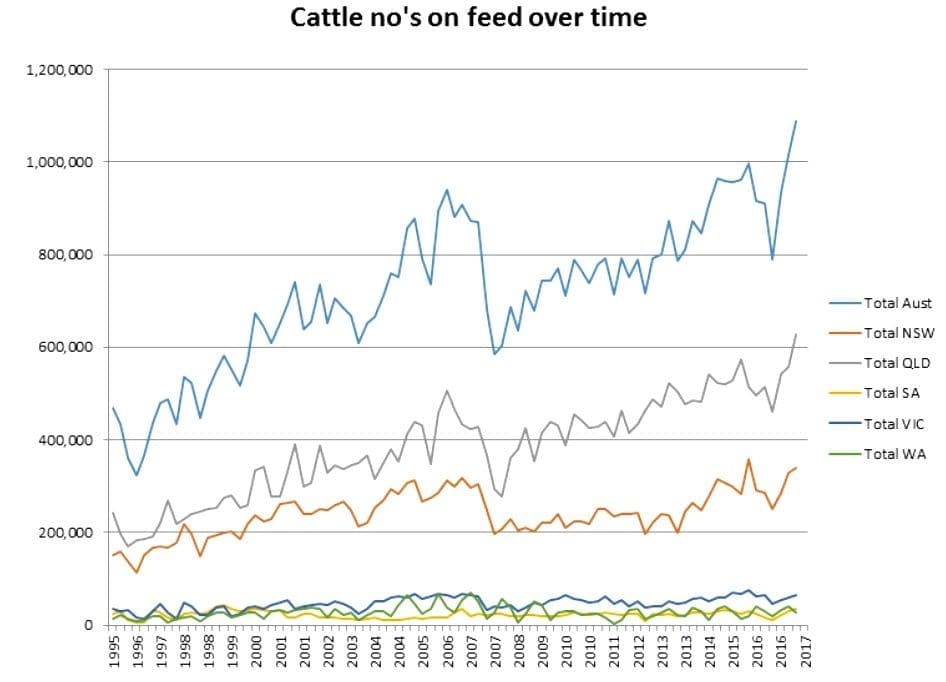AFTER crashing through the one million head barrier for the first time in the March quarter, numbers on feed across the Australian feedlot industry continue to expand, hitting a new record high around 1.1 million head in the quarter ended June 30.
The latest quarterly industry survey released this morning showed an increase of 72,597 head, or 7.1 percent over the March quarter across Australia, impacted somewhat by rapidly deteriorating seasonal conditions across large parts of Queensland and NSW.
Overall numbers on feed at the end of June hit 1,089,072 head, with increases reported in all states apart from Western Australia. Add the 13,000-odd Angus cattle typically on feed in Jusco’s Tasmania feedlot near Powranna (Tasmania results not included in this survey) and the national number indeed goes past 1.1m.
Queensland feeding activity dominated the changes in the June quarter, lifting a dramatic 12 percent on the march quarter, or almost 70,000 head, to a new record high of almost 627,000 head on feed. Contributing to that was a reported 30,000 head increase in the state’s feedlot capacity, now not far off 700,000 head.
By far the largest portion of Queensland’s growth in numbers was reported in the largest yards, 10,000 head or more in capacity, which leapt almost 60,000 head. Smaller and opportunity yards were much less affected.
New South Wales, the second largest lotfeeding state, reported only marginal increase between March and June quarters, up about 9000 head. Feeding capacity in the state actually retracted marginally over the same period, to less than 390,000 head.
Victoria, where seasonal conditions are considerably better, showed only a modest increase, lifting 4000 head to 64,000 on feed, while South Australia also lifted about 4000 head (14pc), to 34,200 head.
The outlier was Western Australia, which saw a typical seasonal decline by 36pc to 25,668 head. Dramatic swings occur each year in lotfeeding activity in WA, based on summer/winter pasture availability (reference see-sawing green line in the above graph).
The June survey also suggested that with recent expansions happening at a number of established yards in Queensland, national feedlot capacity continues to grow, reaching 1.266 million head.
Australian Lot Feeders Association president Tess Herbert said the results reflected an exciting period in the feedlot sector, and supported an underlying level of confidence in the grainfed production system.
“Supply chains are continuing to recognise the importance that the Australian grainfed beef production system plays in enabling brand owners to meet the demand for high quality beef every day of the week,” Ms Herbert said.
This longer-term confidence in the sector was reflected in the level of capital works and expansion projects underway commercially, she said.
“The record number of cattle on feed and increase in capacity reported in this quarter’s survey reinforces the underlying confidence the sector is experiencing at the moment.”
Recent seasonal conditions had impacted cattle and grain prices over the last quarter, further demonstrating lot feeders’ resilience to ever-changing market dynamics, Ms Herbert said.
Despite these normal market dynamics, the upward trend in numbers on feed and investment in the sector illustrated the depth to which grainfed product and production system were embedded in the Australian beef industry.
“The grainfed industry continues to demonstrate its ability to produce high quality beef that consistently meets customer’s expectations.”
Deteriorating conditions impact feeder prices
Meat & Livestock Australia’s manager of data intelligence, Damon Holmes, said the national saleyard feeder steer indictor was buoyed in the first half of the 2016-17 fiscal year by historically high cattle prices.
However deteriorating seasonal conditions over the last couple of months, combined with a poor rainfall outlook had resulted in restocker demand subsiding somewhat, putting downward pressure on the feeder cattle market, he said.
“This has seen more feeder cattle buyer activity within the store market,” Mr Holmes said.
Feedgrain prices had averaged lower in the 2016-17 fiscal year, on the back of high global production.
“The 2016-17 year represented Australia’s largest year of grain production on record,” he said. Wheat ex-Darling Downs averaged $238/tonne, while barley averaged $218/t – both 17pc lower year-on-year, while sorghum was 9pc lower, averaging $231/t. Similarly, wheat ex-Riverina eased 23pc year-on-year, averaging $211/t and barley settled on $174/t for the 12 month period, back 28pc.
“More recently, the forecast decline in grain production has resulted in prices recovering somewhat, however this has been partially mitigated by decreasing livestock prices,” Mr Holmes said.
The ALFA/MLA quarterly survey no longer reports feedlot occupancy levels. However if the reported national number on feed is divided by the reported industry capacity for June, it suggests an occupancy of above 86 percent. In Queensland, it is above 90pc. Such a figure is not far off operating at capacity, given necessary pen vacancies caused by maintenance, pen manure scraping and other activity.
Includes content supplied by ALFA/MLA




HAVE YOUR SAY